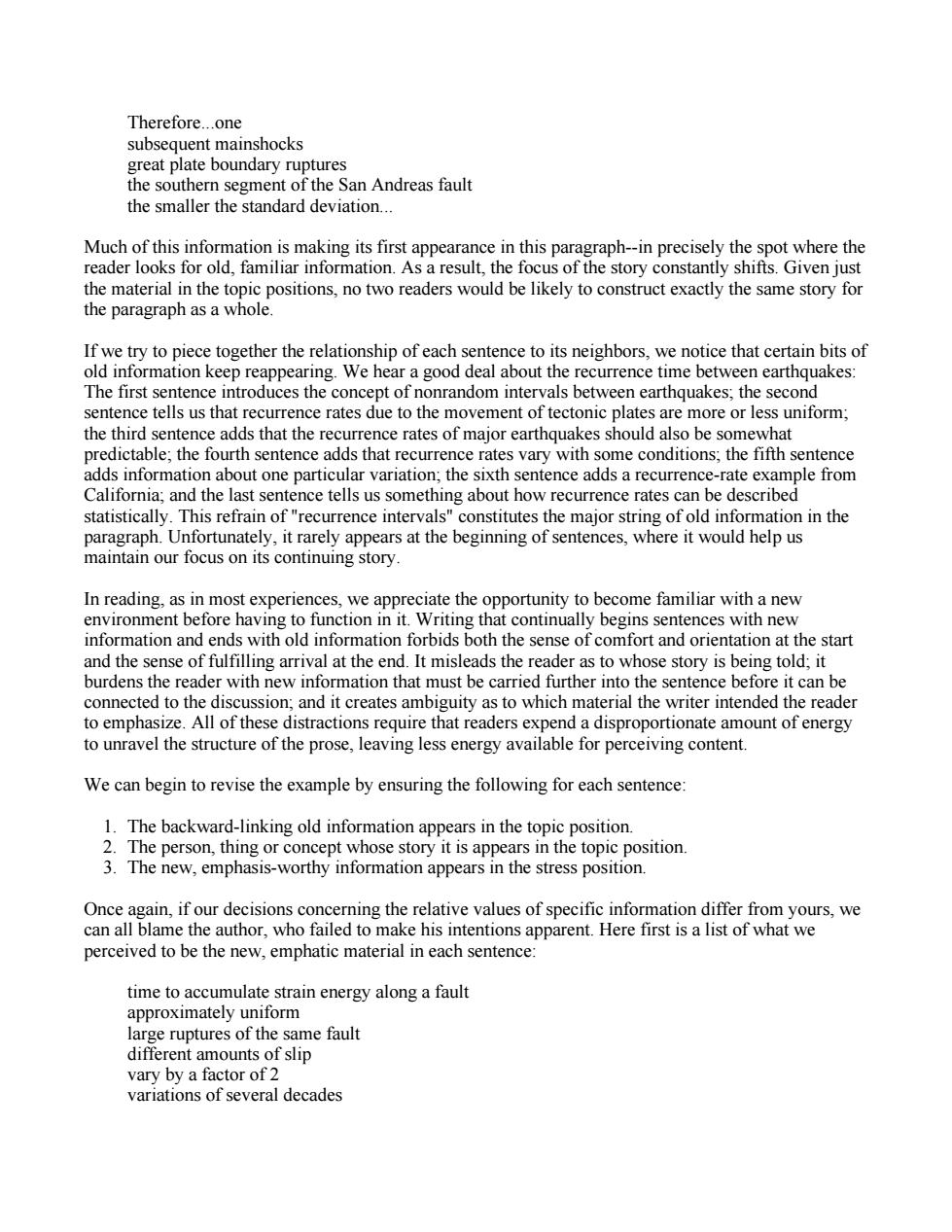正在加载图片...

Therefore...one subsequent mainshocks great plate boundary ruptures the southern segment of the San Andreas fault the smaller the standard deviation... Much of this information is making its first appearance in this paragraph--in precisely the spot where the reader looks for old,familiar information.As a result,the focus of the story constantly shifts.Given just the material in the topic positions,no two readers would be likely to construct exactly the same story for the paragraph as a whole. If we try to piece together the relationship of each sentence to its neighbors,we notice that certain bits of old information keep reappearing.We hear a good deal about the recurrence time between earthquakes: The first sentence introduces the concept of nonrandom intervals between earthquakes;the second sentence tells us that recurrence rates due to the movement of tectonic plates are more or less uniform; the third sentence adds that the recurrence rates of major earthquakes should also be somewhat predictable;the fourth sentence adds that recurrence rates vary with some conditions;the fifth sentence adds information about one particular variation;the sixth sentence adds a recurrence-rate example from California;and the last sentence tells us something about how recurrence rates can be described statistically.This refrain of "recurrence intervals"constitutes the major string of old information in the paragraph.Unfortunately,it rarely appears at the beginning of sentences,where it would help us maintain our focus on its continuing story. In reading,as in most experiences,we appreciate the opportunity to become familiar with a new environment before having to function in it.Writing that continually begins sentences with new information and ends with old information forbids both the sense of comfort and orientation at the start and the sense of fulfilling arrival at the end.It misleads the reader as to whose story is being told;it burdens the reader with new information that must be carried further into the sentence before it can be connected to the discussion;and it creates ambiguity as to which material the writer intended the reader to emphasize.All of these distractions require that readers expend a disproportionate amount of energy to unravel the structure of the prose,leaving less energy available for perceiving content. We can begin to revise the example by ensuring the following for each sentence: 1.The backward-linking old information appears in the topic position. 2.The person,thing or concept whose story it is appears in the topic position. 3.The new,emphasis-worthy information appears in the stress position Once again,if our decisions concerning the relative values of specific information differ from yours,we can all blame the author,who failed to make his intentions apparent.Here first is a list of what we perceived to be the new,emphatic material in each sentence: time to accumulate strain energy along a fault approximately uniform large ruptures of the same fault different amounts of slip vary by a factor of 2 variations of several decadesTherefore...one subsequent mainshocks great plate boundary ruptures the southern segment of the San Andreas fault the smaller the standard deviation... Much of this information is making its first appearance in this paragraph--in precisely the spot where the reader looks for old, familiar information. As a result, the focus of the story constantly shifts. Given just the material in the topic positions, no two readers would be likely to construct exactly the same story for the paragraph as a whole. If we try to piece together the relationship of each sentence to its neighbors, we notice that certain bits of old information keep reappearing. We hear a good deal about the recurrence time between earthquakes: The first sentence introduces the concept of nonrandom intervals between earthquakes; the second sentence tells us that recurrence rates due to the movement of tectonic plates are more or less uniform; the third sentence adds that the recurrence rates of major earthquakes should also be somewhat predictable; the fourth sentence adds that recurrence rates vary with some conditions; the fifth sentence adds information about one particular variation; the sixth sentence adds a recurrence-rate example from California; and the last sentence tells us something about how recurrence rates can be described statistically. This refrain of "recurrence intervals" constitutes the major string of old information in the paragraph. Unfortunately, it rarely appears at the beginning of sentences, where it would help us maintain our focus on its continuing story. In reading, as in most experiences, we appreciate the opportunity to become familiar with a new environment before having to function in it. Writing that continually begins sentences with new information and ends with old information forbids both the sense of comfort and orientation at the start and the sense of fulfilling arrival at the end. It misleads the reader as to whose story is being told; it burdens the reader with new information that must be carried further into the sentence before it can be connected to the discussion; and it creates ambiguity as to which material the writer intended the reader to emphasize. All of these distractions require that readers expend a disproportionate amount of energy to unravel the structure of the prose, leaving less energy available for perceiving content. We can begin to revise the example by ensuring the following for each sentence: 1. The backward-linking old information appears in the topic position. 2. The person, thing or concept whose story it is appears in the topic position. 3. The new, emphasis-worthy information appears in the stress position. Once again, if our decisions concerning the relative values of specific information differ from yours, we can all blame the author, who failed to make his intentions apparent. Here first is a list of what we perceived to be the new, emphatic material in each sentence: time to accumulate strain energy along a fault approximately uniform large ruptures of the same fault different amounts of slip vary by a factor of 2 variations of several decades